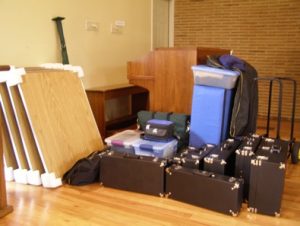Concert preparation falls into two broad categories: music and logistics. I’ll talk about music first, and logistics another time. Continue reading Concert prep cycle – music
All posts by nkirkner
Kodály musicianship training
If you’re looking for general musicianship training, consider a Kodály course this summer, which may be offered in a city near you. The Organization of American Kodály Educators (OAKE) has chapters in many major metropolitan areas. Certified instructors run the “levels” courses to teach the Kodály method of music education. In the broadest terms, this method incorporates singing (especially folk songs), solfège, and games to teach music to children. There are 4 levels of certification, with each building on prior levels. In addition to coursework, Kodály students must submit a video of themselves teaching a class using the principles of the previous level to advance to the next. The curriculum consists of methods and materials, choral conducting, singing in a choir under the direction of a master conductor, solfège, and music dictation. Continue reading Kodály musicianship training
Recording permission and mechanical licenses
Making recordings in any form is one of the rights assigned exclusively to the copyright holder under copyright law. This is partly what the notice “All rights reserved” means. Although technology has changed rapidly, copyright law has not. We’re still bound by the laws on the books, however laxly enforced. If you haven’t already read my articles on Performance royalties and copyright, as well as Photocopies and “fair use,” you may find them helpful in understanding these issues. Today’s article covers audio recording licenses; I’ll write another time about video recording, as well as broadcasting via YouTube or other media. Continue reading Recording permission and mechanical licenses
Landmarks
A reader asked me to elaborate on how I use the pins mentioned in the gadget box section of the Concert equipment article. This started me thinking about the whole topic of table landmarks. With many other instruments, the pitch position is fixed (like a piano keyboard or harp strings) and the musician stays anchored to a bench or chair. Handbell soloists move along the table; the bells move around the table. We need all the help we can get keeping track of our instrument. Enter the pins. Continue reading Landmarks
Concert equipment and transport
 The amount of equipment required is one of the limiting factors in solo handbell performances, and it took a while to sort out the best way to handle it all. For one of my concerts, I transported everything shown here surrounding the organ console and bench. Continue reading Concert equipment and transport
The amount of equipment required is one of the limiting factors in solo handbell performances, and it took a while to sort out the best way to handle it all. For one of my concerts, I transported everything shown here surrounding the organ console and bench. Continue reading Concert equipment and transport
Photocopies and “fair use”
Making copies in any form is one of the rights assigned exclusively to the copyright holder under copyright law. In addition to the usual copyright notice of “All rights reserved,” publishers sometimes use stronger wording to reinforce that photocopying sheet music is illegal. As handbell musicians, we want to do the right thing, but that can be difficult with so much misinformation floating about.
Read here about:
• The myth of the ‘working copy’
• Ways to accommodate copying restrictions
• What “fair use” really means Continue reading Photocopies and “fair use”
Performance royalties (ASCAP) and copyright
Most copyrighted music has a notation “All rights reserved,” or something similar. Copyright law assigns numerous rights exclusively to the copyright holder, including the right to perform the work publicly. Of course, composers want you to perform their published works, since you have little reason to buy sheet music otherwise. However, royalties are owed to the copyright holder whenever copyrighted music is performed in public. Just buying sheet music isn’t sufficient.
Read here about:
• How to determine whether royalties are owed
• Who must pay performing royalties
• How, when, and where to pay the royalties Continue reading Performance royalties (ASCAP) and copyright
Comprehensive choreography example
Over the last 4 months, I’ve been writing here about the principles and techniques that allow us to choreograph music for solo bells. In this example, I’ll walk you through a piece and explain my thought process and the decisions I make. There’s no single right answer to choreography; there’s only the solution that makes most musical sense for an individual musician. I’ve chosen this example specifically for the problems it presents and the variety of techniques employed in my solution. A typical solo would be less complicated. There’s a video of the entire piece at the end, and I’ll walk you through the score in sections. Continue reading Comprehensive choreography example
How I approach choreographing a piece
Some soloists approach choreographing and learning a piece differently than I do, and you may prefer their method, or another way you discover. This is what works for me. Most of my repertoire isn’t written for solo handbells; my accompanist and I adapt it from other instruments. I wrote about this in Transcribing for solo handbells. Before I start the choreography, I have some sort of score, either purchased, downloaded, or created in Sibelius. I also run that arrangement by my accompanist for her input before I invest any time in it. While I’m working out the choreography for a piece, I devote most of each practice session to it until it’s fully choreographed. For that reason, I develop choreography for only one piece at a time. Continue reading How I approach choreographing a piece
Movement and dynamics
In this article, you can read about:
• Picking up bells faster,
• Avoiding the Dreaded Banana,
• Creating basic dynamic effects,
• Increasing your range of motion,
• Cringe-worthy movement mistakes, and
• A secret. Continue reading Movement and dynamics